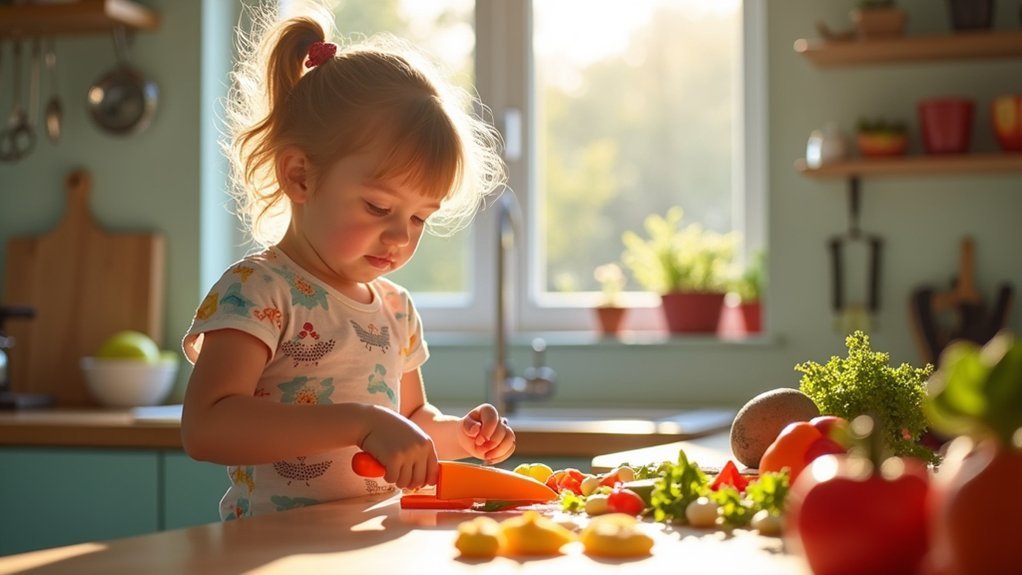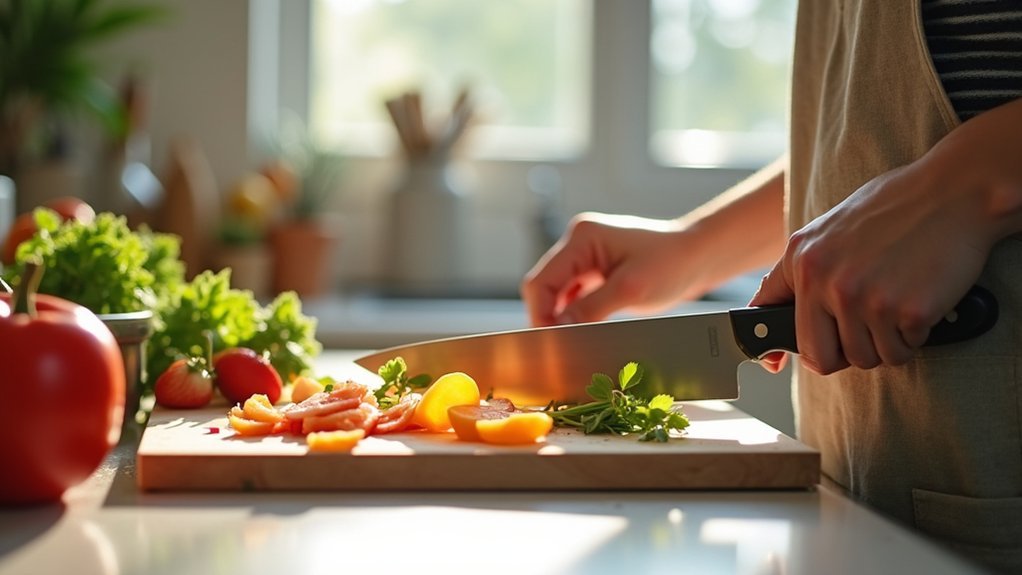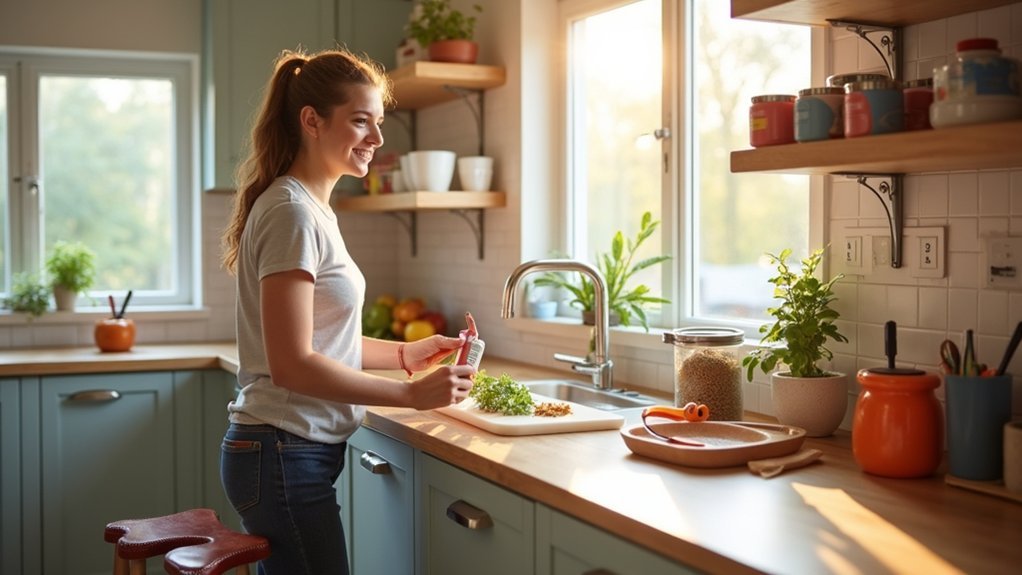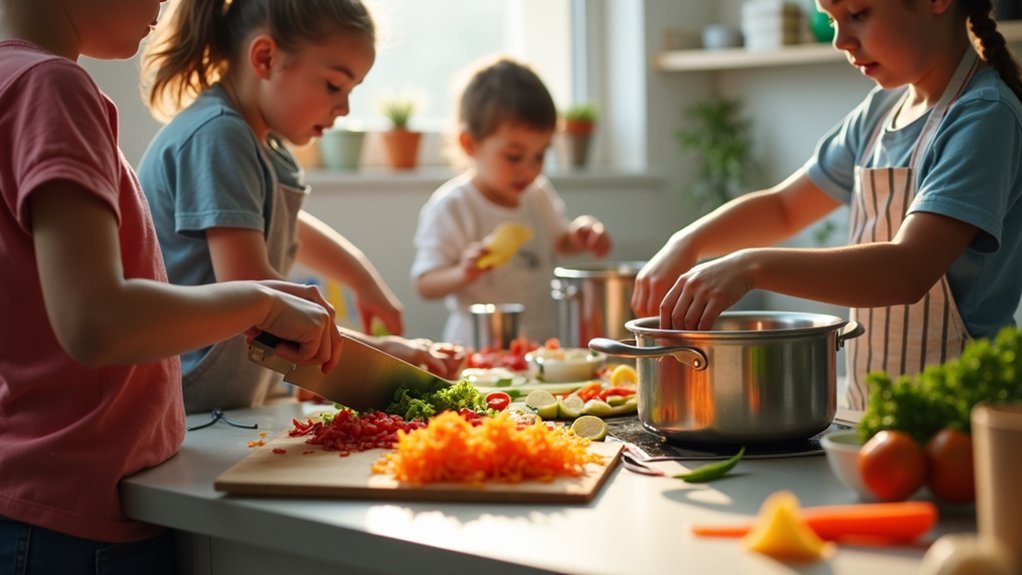Cooking offers a practical way to boost motor function through tasks like stirring, chopping, and kneading. You’ll develop fine and gross motor skills while creating delicious meals. Try adaptive tools with ergonomic grips, non-slip bases, and one-handed designs to accommodate mobility limitations. Start with simple recipes and gradually increase complexity as your coordination improves. Track your progress by measuring task completion times and grip strength improvements. The kitchen holds the key to enhanced independence and confidence.
The Connection Between Cooking and Motor Function Development

While many view cooking as merely a means to prepare meals, it actually serves as a powerful developmental tool for motor function. When you engage in cooking activities, you’re simultaneously enhancing both fine and gross motor skills through precise actions like chopping, stirring, and carrying ingredients.
Research confirms that children who participate in cooking show significant improvements in motor coordination. Your child’s fine motor development benefits from tasks requiring controlled movements like spreading and mashing, while gross motor skills improve through activities demanding balance and full-body coordination. Using age-appropriate tasks during cooking sessions helps children develop confidence in their abilities while mastering essential motor skills.
The beauty of cooking lies in its adaptability across age groups. Whether you’re working with a toddler or teenager, kitchen activities can be tailored to support appropriate developmental milestones, combining motor skill enhancement with cognitive benefits like numeracy and literacy.
Essential Adaptive Kitchen Tools for Mobility Limitations
You’ll find stabilizing tools with non-slip bases and weighted handles essential for maintaining control while cooking with mobility challenges.
One-handed cooking techniques become possible with specialized cutting boards featuring food-securing clamps and pegs.
Ergonomic utensils with padded grips can transform your kitchen experience, reducing fatigue and increasing your independence during meal preparation. Swivel utensils can be particularly helpful for individuals with minimal muscle control who struggle to keep food on standard utensils while eating.
Stabilizing Tools Matter
For individuals with mobility limitations, the kitchen can present numerous challenges that affect safety and independence. Integrating stabilizing tools can greatly improve your cooking experience.
Consider investing in cutting boards with suction cups to prevent unwanted movement while chopping. Non-slip mats keep items secure on countertops, while heavy-bottomed pots provide essential stability on stovetops. Tools with ergonomic handles reduce fatigue and enhance grip control during extended use. The Kiessco Rocker Knife with its centered handle design allows for easier one-handed slicing for those with limited mobility.
Adjustable height counters allow you to position work surfaces at comfortable levels, minimizing strain. When handling hot items, choose utensils with heat-insulated handles and oven mitts with grip enhancements to prevent accidents.
Silicone spatulas and thermal tongs offer temperature resistance while maintaining secure control of food items during preparation and serving.
One-Handed Cooking Techniques
Beyond stabilizing tools, mastering one-handed cooking techniques can greatly expand your kitchen capabilities if you have mobility challenges.
Invest in specialized utensils like angled spoons, splayds, and rocker knives that simplify food preparation and consumption. You’ll find built-up handles and palmar cuff orthoses particularly helpful for improving your grip on cutlery.
When arranging your kitchen, position workstations strategically to minimize movement and reduce strain. Keep frequently used items within easy reach.
Pre-planning your meals and choosing simpler recipes will streamline your cooking process. Don’t hesitate to use pre-cut ingredients or electric appliances when needed. Consider using a pizza cutter instead of a knife for easily slicing flat foods like quesadillas and sandwiches.
Remember that regular practice with these adaptive tools not only makes cooking easier but also contributes to improving your overall motor function and independence.
Graduated Cooking Techniques for Fine Motor Skill Enhancement

As children develop at different rates, graduated cooking techniques provide a structured pathway to enhance fine motor skills through progressive challenges. You’ll see improvements in your child’s dexterity when cooking activities match their developmental stage and gradually increase in complexity. Research shows that children who engage in regular cooking activities develop healthier dietary patterns that often continue into adulthood.
| Age Group | Key Skills | Benefits |
|---|---|---|
| Toddlers | Stirring, mashing | Builds basic grip strength |
| Preschoolers | Spreading, pouring | Develops coordination |
| School-age | Measuring, cutting | Enhances precision |
Research confirms that customized cooking approaches allow children to learn at their own pace while consistently improving motor function. By deconstructing cooking tasks into developmental components, you’re creating a therapeutic learning environment that’s both engaging and effective. The structured progression guarantees children remain challenged without becoming frustrated, making cooking an ideal medium for motor skill development.
Therapeutic Stirring, Chopping, and Mixing Exercises
When incorporated into rehabilitation programs, therapeutic stirring, chopping, and mixing exercises provide powerful neurological benefits while making recovery more engaging.
These activities stimulate your cerebellum and promote neural plasticity, which is essential for recovering from neurological damage.
You’ll notice improvements in hand-eye coordination and dexterity as you progress through customizable stirring exercises.
Chopping tasks refine your motor control while enhancing cognitive planning abilities.
Mixing activities can be particularly beneficial for social interaction when performed in group settings.
These culinary exercises aren’t just practical—they’re adaptable for various skill levels and rehabilitation needs.
Whether you’re recovering from a stroke or working on general motor skill enhancement, these tasks offer meaningful therapy that builds confidence and fosters independence in daily living activities.
At TriHealth’s comprehensive stroke program, occupational therapists like Lesa Saunders help patients develop kitchen maneuvering skills that are crucial for regaining independence.
Kitchen Setup Modifications for Maximum Independence

Mastering cooking skills for motor rehabilitation requires more than therapeutic exercises—your kitchen environment itself plays a vital role in supporting independence. By making strategic adjustments to your kitchen layout, you’ll create efficient pathways that minimize walking distances and reduce fall risks. Many stroke survivors experience tremendous improvements in their daily functioning when using adaptive kitchen aids that accommodate their specific abilities.
| Modification Type | Benefit | Implementation Tip |
|---|---|---|
| Ergonomic Heights | Reduces joint strain | Adjust counters for seated work |
| Contrast Colors | Improves visual focus | Use dark cutting boards on light counters |
| Lever Handles | Eases operation | Replace round knobs on faucets |
| Pull-Out Shelves | Minimizes reaching | Convert stationary shelves to sliding |
Consider installing anti-skid flooring to prevent slips while you’re working. Position workstations near supportive surfaces where you can stabilize yourself, and invest in adaptive tools like easy-grip utensils and one-handed devices that compensate for limited dexterity.
Sensory-Friendly Recipe Selection for Motor Coordination
Start your cooking journey with tactile-forward tools that provide clear sensory feedback, such as silicone spatulas with textured handles or measuring cups with pronounced grips.
You’ll notice immediate improvements in grip strength and dexterity when these tools become regular parts of your kitchen routine.
Activities like stirring, folding, and kneading naturally develop fine motor skills while creating delicious results everyone can enjoy.
As you progress, introduce recipes with gradually increasing textural complexity, moving from smooth batters to more resistant doughs that require additional motor control.
Tactile-Forward Kitchen Tools
The world of adaptive kitchen tools offers remarkable benefits for individuals seeking to enhance motor coordination through cooking activities.
These specialized implements provide both sensory feedback and physical support while engaging in food preparation tasks. Kid-safe toothpicks and small cocktail forks can help children with sensory challenges maintain distance while still interacting with foods.
- Silicone-coated spoons and easy-grip utensils enhance tactile input while reducing motor demands, making eating and cooking more accessible.
- Kitchen choppers allow interaction with food without direct contact, providing proprioceptive input that helps maintain posture and balance.
- Sensory cutters develop fine motor skills through controlled movements while promoting independence in the kitchen.
- Texture exploration tools like straws enable sensory engagement with foods without triggering tactile defensiveness.
Gradual Texture Progression
While developing motor skills through cooking, understanding texture progression is essential for creating successful, sensory-friendly culinary experiences.
Start with recipes involving smooth purees before advancing to those with soft lumps. Choose dishes that blend uniform textures with small chunks to bridge sensory gaps. For beginners, select muffins, pasta, or yogurt melts that require minimal chewing effort yet encourage oral exploration. Implementing a proper sensory diet helps children build tolerance for different food textures through systematic exposure in cooking activities.
As skills develop, gradually introduce recipes with varied textures—moving from thin purees to thicker consistencies, then to foods requiring more complex chewing. Monitor your comfort level at each stage before advancing.
When introducing new textures, pair them with familiar favorites to increase acceptance. This methodical approach prevents sensory overwhelm while systematically building the motor coordination needed for more advanced cooking techniques.
Progress Tracking: Measuring Motor Gains Through Culinary Activities

Effectively monitoring your progress in motor rehabilitation requires systematic measurement approaches that cooking activities uniquely provide.
You’ll gain valuable data on your rehabilitation journey by tracking specific metrics during culinary tasks. Time how long it takes to complete chopping vegetables or decorating cookies, then watch those times improve as your skills develop. Cooking activities significantly enhance fine motor skills while providing meaningful measurements of progress.
- Track grip strength improvements by measuring force before and after regular dough kneading sessions
- Count successful egg cracks without shell fragments as a precise measure of bilateral coordination
- Monitor independent utensil use duration to quantify functional independence gains
- Record error rates when following multi-step recipes to assess cognitive-motor integration progress
These objective measurements transform everyday cooking activities into powerful rehabilitation tools, giving you concrete evidence of your improving motor function.
Group Cooking Sessions for Social and Physical Rehabilitation
Moving beyond individual progress tracking, group cooking sessions offer a powerful combination of social connection and physical rehabilitation benefits.
When you join a cooking group, you’ll experience reduced isolation while simultaneously improving fine motor skills and hand function.
These sessions create a supportive environment where you can practice balance, coordination, and range of motion exercises through practical kitchen tasks.
You’ll learn energy conservation techniques while engaging in activities that require concentration and memory, enhancing cognitive recovery.
The shared meals at the end of sessions foster bonding and community, particularly valuable for burns survivors who report that cooking helps them meet new people.
This therapeutic approach distracts from recovery challenges, decreases anxiety, and builds confidence while you develop vocational skills that support your independence. Cooking therapy serves as a healthy coping mechanism for managing stress and emotions commonly experienced during addiction recovery.
Frequently Asked Questions
How Do Cultural Food Preferences Impact Adaptive Cooking Interventions?
Your cultural food preferences enhance adaptive cooking interventions by making them more relevant, engaging, and effective. When you’re working with familiar ingredients and techniques, you’ll likely experience improved participation and better health outcomes.
Can Cooking Therapy Help With Neurological Tremors?
Yes, cooking therapy can help with your neurological tremors. You’ll strengthen fine motor skills through repetitive tasks, improve dexterity using adapted utensils, and potentially reduce tremor impact while gaining confidence in daily activities.
What Insurance Typically Covers Kitchen-Based Occupational Therapy?
Most health insurance plans cover kitchen-based occupational therapy when it’s medically necessary and prescribed by a physician. You’ll find coverage through Medicare, commercial insurers, and business owner’s policies, though coverage limits vary widely.
How Long Before Seeing Improvements in Motor Skills Through Cooking?
You’ll likely notice improvements in motor skills within 3-6 weeks of regular cooking practice. Consistency is key—aim for 2-3 sessions weekly. Children typically show faster progress than adults with age-appropriate tasks.
Are Virtual Cooking Programs Effective for Remote Motor Rehabilitation?
Yes, virtual cooking programs can be effective for remote motor rehabilitation. You’ll benefit from their immersive environments, personalized feedback, and task-specific practice that transfers to real-life skills while receiving professional telesupervision from home.
In Summary
You’ve now learned how cooking can transform your rehabilitation journey. By incorporating adaptive tools, modified techniques, and purposeful kitchen activities, you’ll strengthen your motor skills while gaining independence. Remember to track your progress and consider joining group sessions for added motivation. Whether you’re stirring, chopping, or measuring, each culinary action is a meaningful step toward improved motor function and enhanced quality of life.





Leave a Reply